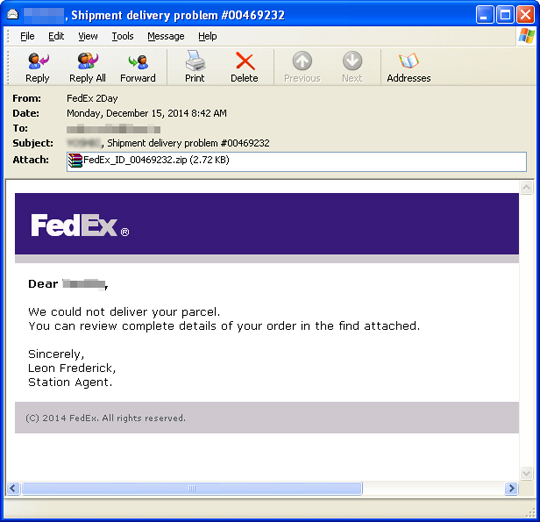JS_MALSCR.NIM
JS/Downloader-BNW (McAfee); Trojan-Downloader.JS.Agent.hch (Kaspersky)
Windows


Threat Type: Trojan
Destructiveness: No
Encrypted: No
In the wild: Yes
OVERVIEW
Downloaded from the Internet, Spammed via email
This Trojan arrives as an attachment to email messages spammed by other malware/grayware or malicious users. It arrives on a system as a file dropped by other malware or as a file downloaded unknowingly by users when visiting malicious sites.
It does not have any propagation routine.
It does not have any backdoor routine.
It executes the downloaded files. As a result, malicious routines of the downloaded files are exhibited on the affected system. As of this writing, the said sites are inaccessible.
It does not have any information-stealing capability.
TECHNICAL DETAILS
9,845 bytes
JS
17 Dec 2014
Connects to URLs/IPs, Downloads files
Arrival Details
This Trojan arrives as an attachment to email messages spammed by other malware/grayware or malicious users.
It arrives on a system as a file dropped by other malware or as a file downloaded unknowingly by users when visiting malicious sites.
Propagation
This Trojan does not have any propagation routine.
Backdoor Routine
This Trojan does not have any backdoor routine.
Download Routine
This Trojan connects to the following website(s) to download and execute a malicious file:
- http://{BLOCKED}amp.org/document.php?id=5450535E130500054A1D0B170C0D0B240E051C054A0E14&rnd=2011701
- http://{BLOCKED}amp.org/document.php?id=5450535E130500054A1D0B170C0D0B240E051C054A0E14&rnd=8071822
- http://{BLOCKED}amp.org/document.php?id=5450535E130500054A1D0B170C0D0B240E051C054A0E14&rnd=8096593
It saves the files it downloads using the following names:
- %User Temp%\15854185.exe
- %User Temp%\51221015.exe
- %User Temp%\27812395.exe
(Note: %User Temp% is the user's temporary folder, where it usually is C:\Documents and Settings\{user name}\Local Settings\Temp on Windows 2000, Windows Server 2003, and Windows XP (32- and 64-bit); C:\Users\{user name}\AppData\Local\Temp on Windows Vista (32- and 64-bit), Windows 7 (32- and 64-bit), Windows 8 (32- and 64-bit), Windows 8.1 (32- and 64-bit), Windows Server 2008, and Windows Server 2012.)
It then executes the downloaded files. As a result, malicious routines of the downloaded files are exhibited on the affected system.
As of this writing, the said sites are inaccessible.
Information Theft
This Trojan does not have any information-stealing capability.
NOTES:
Below is a screenshot of the email:

It does not have rootkit capabilities.
It does not exploit any vulnerability.
SOLUTION
9.700
11.352.02
17 Dec 2014
11.353.00
18 Dec 2014
Step 1
Before doing any scans, Windows XP, Windows Vista, and Windows 7 users must disable System Restore to allow full scanning of their computers.
Step 2
Note that not all files, folders, and registry keys and entries are installed on your computer during this malware's/spyware's/grayware's execution. This may be due to incomplete installation or other operating system conditions. If you do not find the same files/folders/registry information, please proceed to the next step.
Step 3
Search and delete this file
- %User Temp%\15854185.exe
- %User Temp%\51221015.exe
- %User Temp%\27812395.exe
Step 4
Scan your computer with your Trend Micro product to delete files detected as JS_MALSCR.NIM. If the detected files have already been cleaned, deleted, or quarantined by your Trend Micro product, no further step is required. You may opt to simply delete the quarantined files. Please check this Knowledge Base page for more information.
Did this description help? Tell us how we did.

